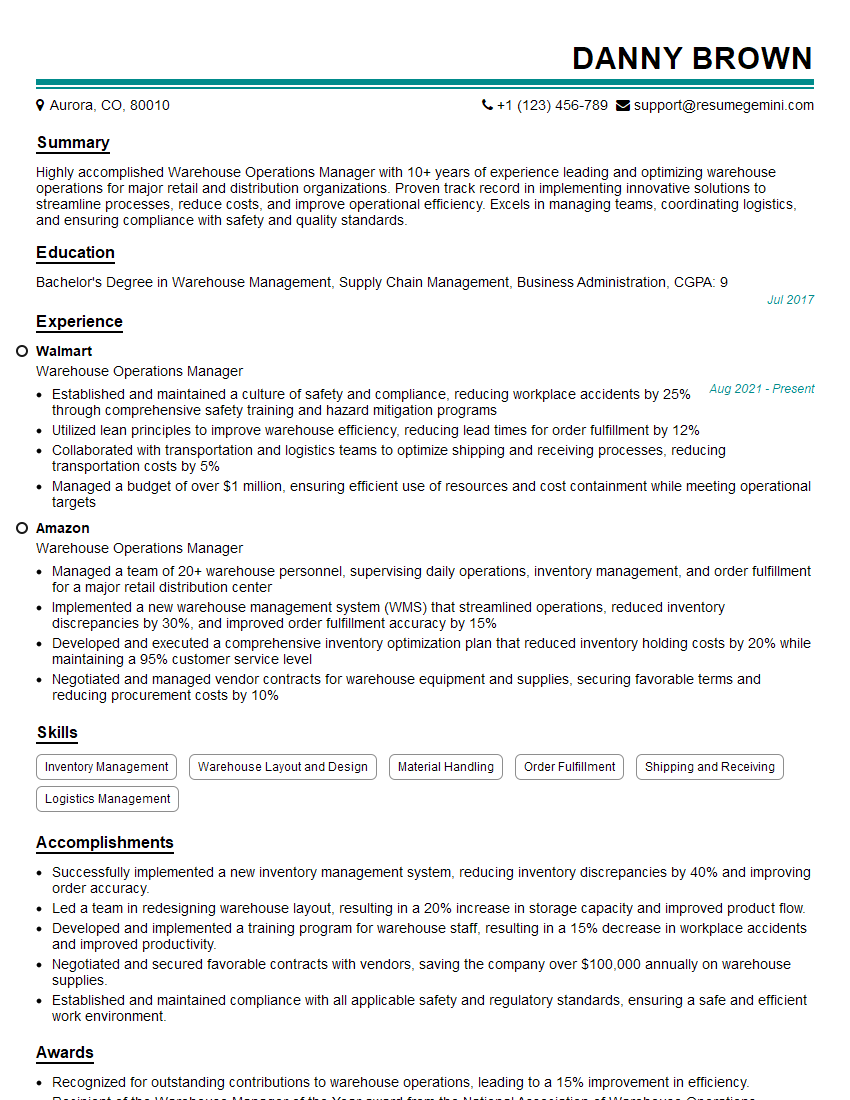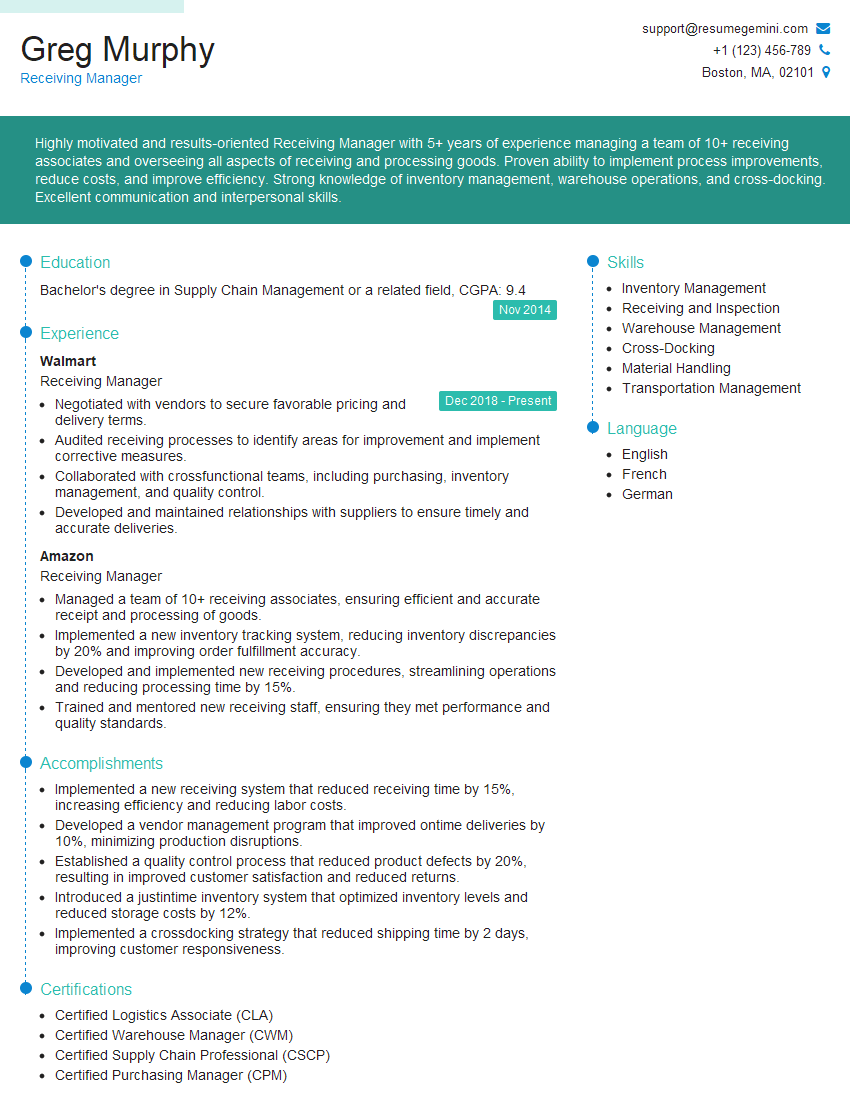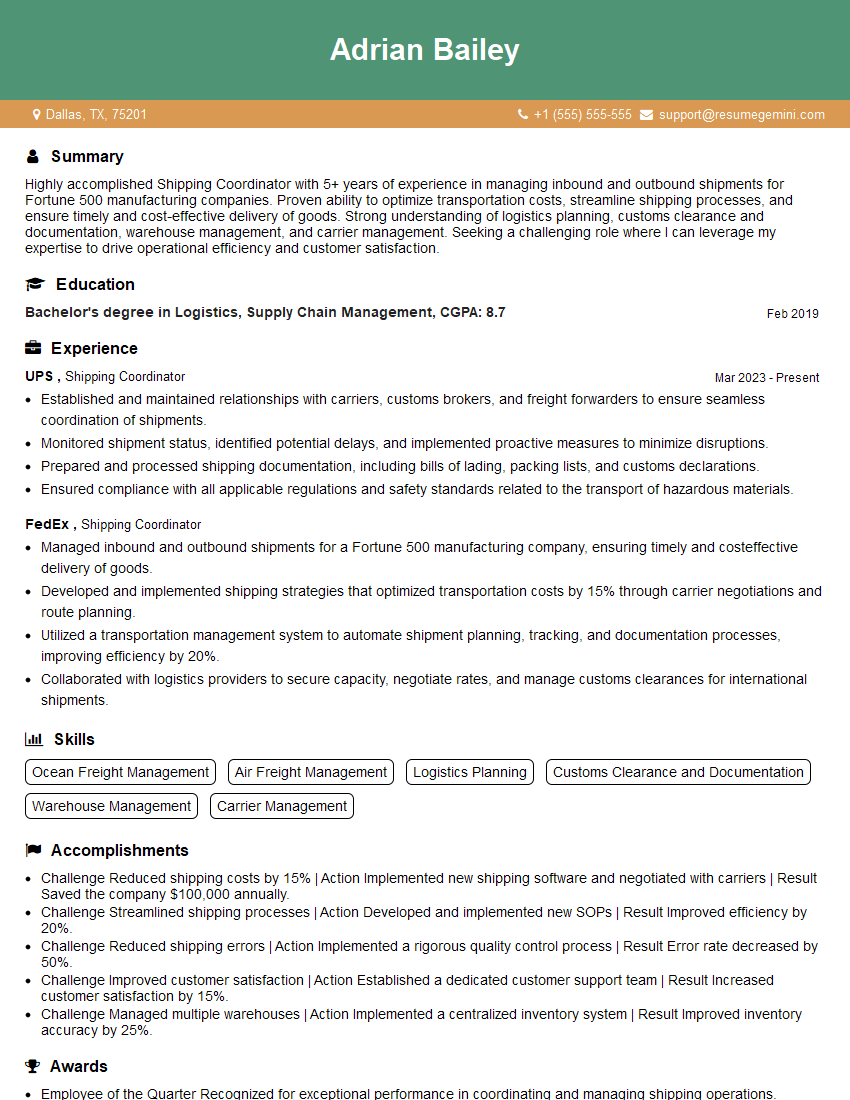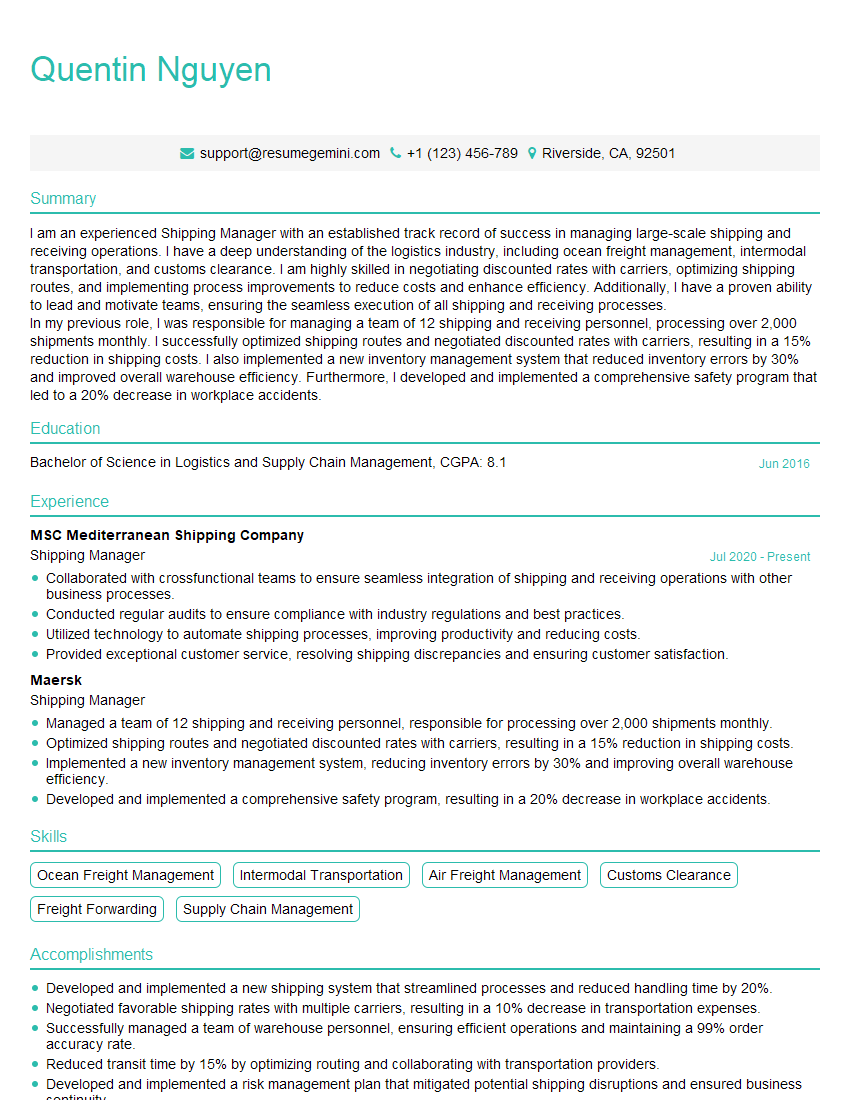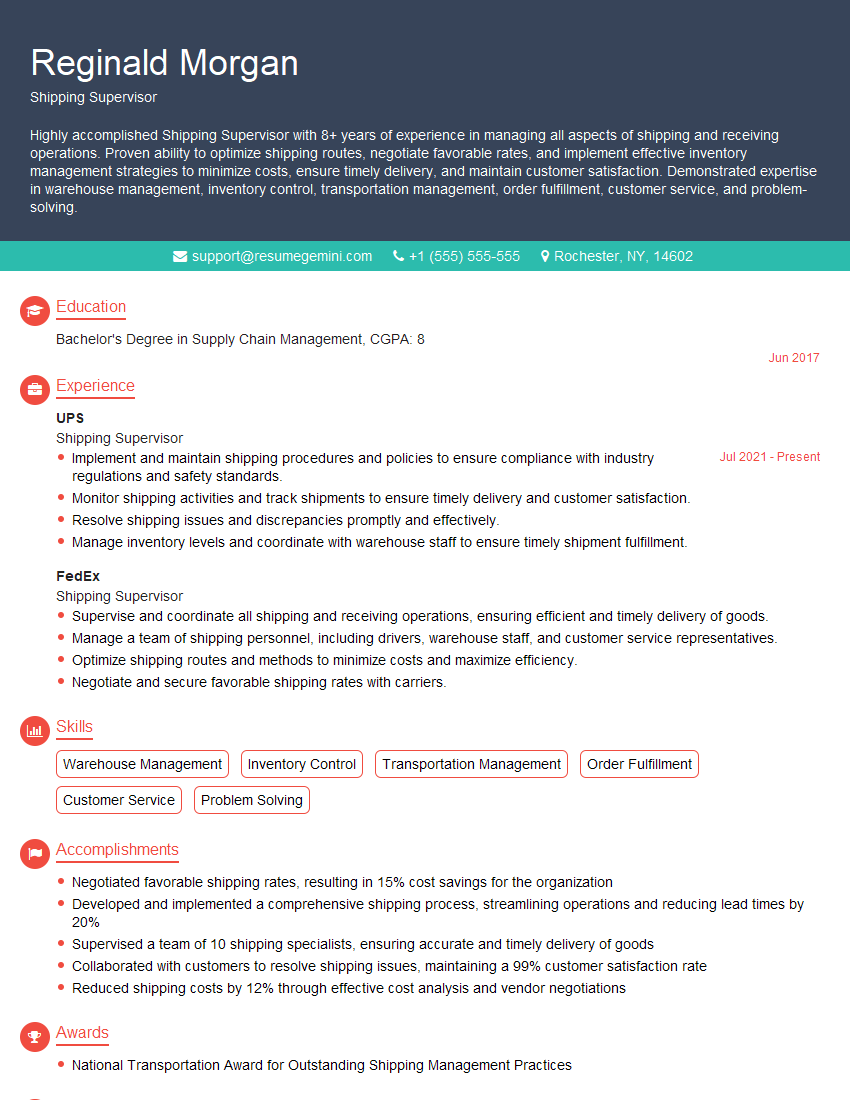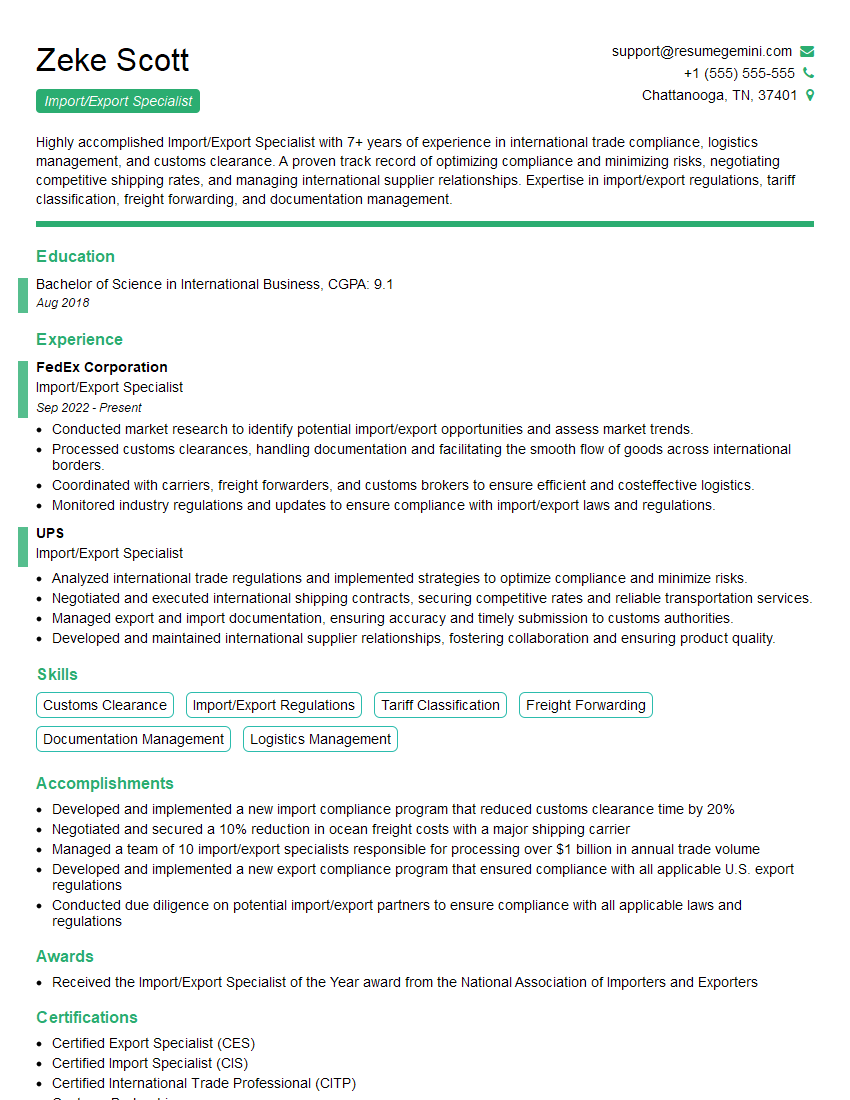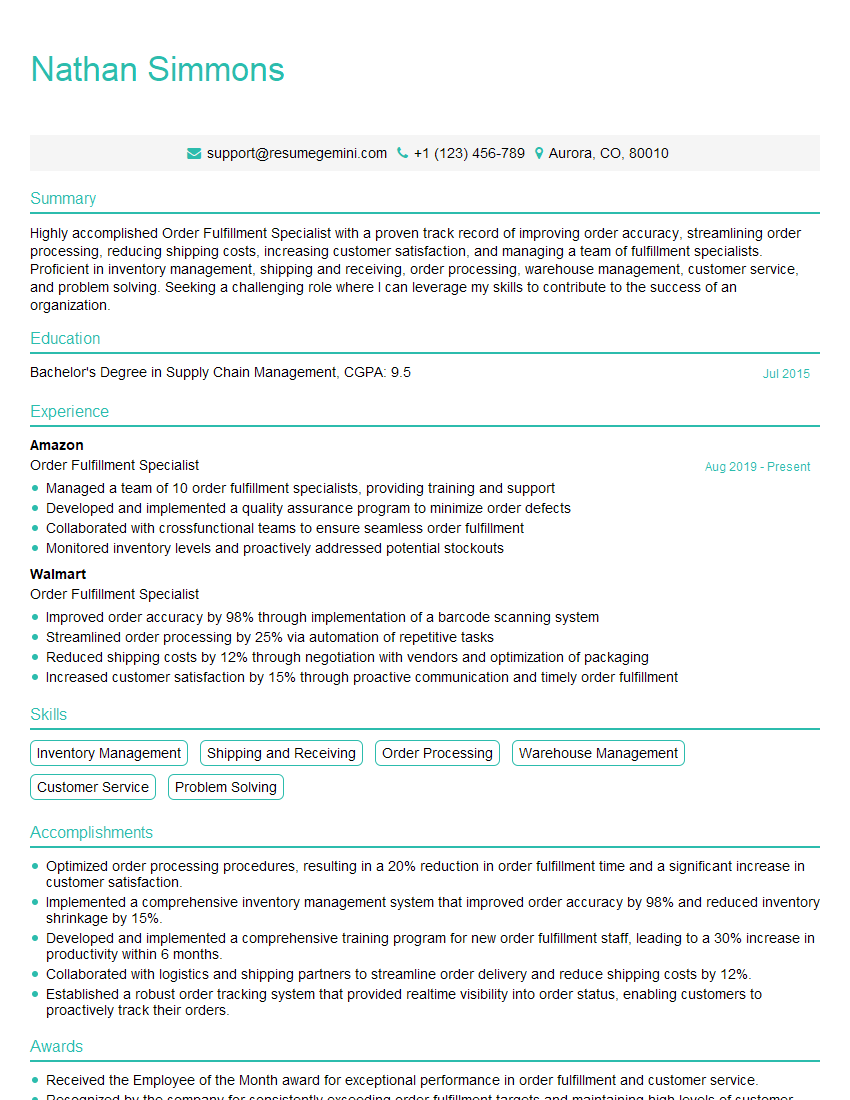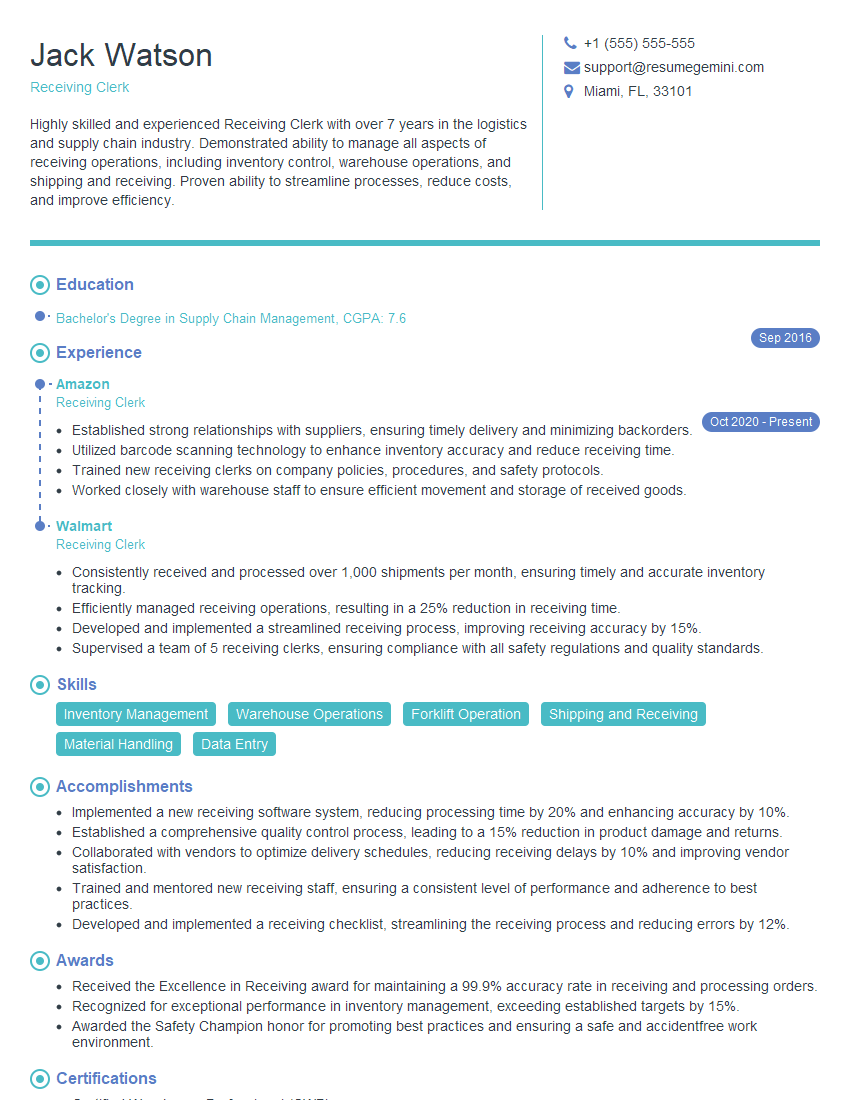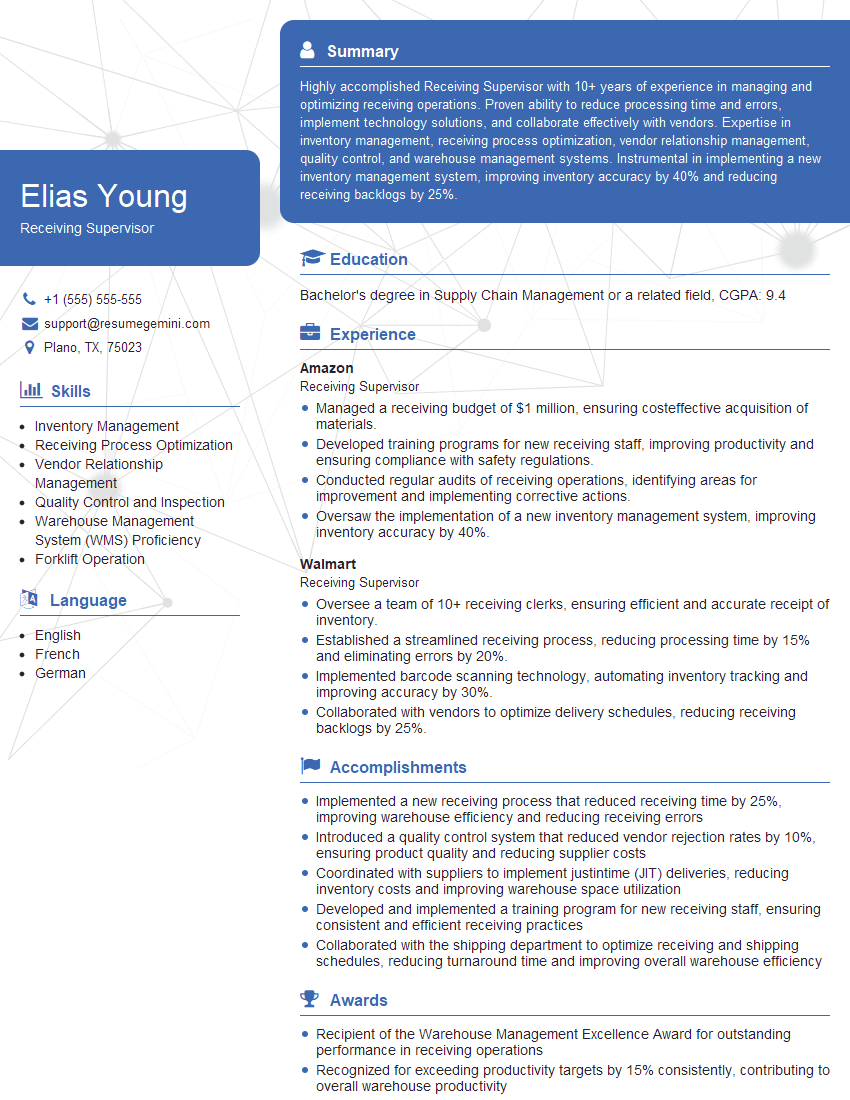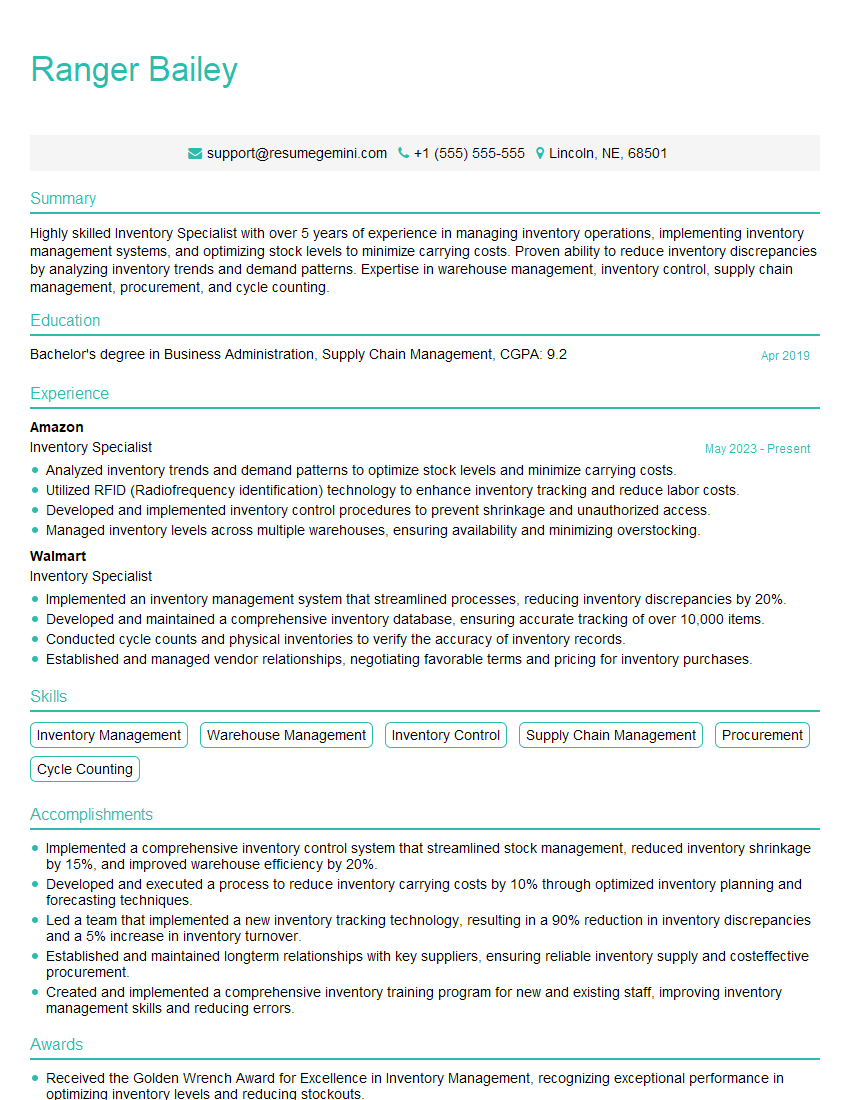The thought of an interview can be nerve-wracking, but the right preparation can make all the difference. Explore this comprehensive guide to Receiving and Shipping Management interview questions and gain the confidence you need to showcase your abilities and secure the role.
Questions Asked in Receiving and Shipping Management Interview
Q 1. Explain the process of receiving incoming shipments.
Receiving incoming shipments is a crucial process that ensures the smooth flow of goods into a warehouse or business. It involves several key steps, starting from the moment a shipment arrives. Think of it like a well-oiled machine – each part needs to function correctly for optimal efficiency.
- Verification: The first step is verifying the shipment against the purchase order or delivery note. This involves checking the quantity, condition of packaging, and the overall accuracy of the items received against the expected order. For example, if we’re expecting 100 boxes of widgets, we verify that we’ve actually received 100 boxes, and they are all undamaged.
- Inspection: A thorough inspection of the received goods is performed to identify any damage or discrepancies. This may include checking for broken seals, damaged products, or incorrect items. A simple visual inspection is usually sufficient, however, depending on the product, more stringent testing (e.g., functionality tests for electronics) might be necessary.
- Quantity Check: Accurate counting of all items received is critical to prevent stock discrepancies. This might involve using handheld scanners to read barcodes or manually counting items, depending on the volume and type of goods. Any discrepancies are immediately documented.
- Documentation: All receiving activities are meticulously documented. This includes noting the date and time of arrival, carrier information, purchase order number, quantity received, and any discrepancies or damages. This documentation is critical for tracking, accounting, and potential returns or claims.
- Put-away: Once verified and documented, the goods are moved to their designated storage locations within the warehouse. Efficient put-away procedures are vital for maintaining an organized and accessible inventory.
A failure in any of these steps can lead to inaccurate inventory counts, delays in production or fulfillment, and financial losses. By adhering to a structured receiving process, businesses can minimize these risks and ensure efficient operations.
Q 2. Describe your experience with inventory management systems.
My experience with inventory management systems spans over eight years, working with both small-scale ERP systems and large-scale WMS platforms. I’m proficient in using systems to track inventory levels, manage stock movements, and generate reports on stock turnover, slow-moving items, and optimal stock levels.
For instance, in my previous role, we implemented a WMS (Warehouse Management System) that integrated with our ERP (Enterprise Resource Planning) system. This allowed for real-time visibility into our inventory levels across multiple warehouses. We were able to identify slow-moving items and optimize storage space, leading to significant cost savings. The system also automated many processes, such as put-away instructions and picking lists, reducing manual errors and improving efficiency.
I am experienced with various functionalities within these systems including: cycle counting procedures, bin location management, lot tracking (for perishable goods and batch-specific items), and reporting and analytics to monitor inventory health and performance. I’m comfortable training others on the usage of these systems and identifying areas for system improvement or process optimization.
Q 3. How do you handle damaged or incorrect shipments?
Handling damaged or incorrect shipments requires a systematic approach to minimize losses and maintain good supplier relationships. The first step is to meticulously document the damage or discrepancy, including photographic evidence and a detailed description. This documentation forms the basis for any claim against the carrier or supplier.
- Notification: The carrier and supplier are immediately notified of the issue, providing them with the necessary documentation. This is crucial for timely resolution.
- Damage Assessment: A thorough assessment of the damage is conducted to determine the extent of the loss or damage. This may involve checking if the items can be salvaged or if they need to be replaced.
- Claim Filing: A formal claim is filed with the appropriate party (carrier or supplier) based on their terms and conditions. It’s vital to keep a record of all communication and documentation related to the claim.
- Internal Procedures: Depending on our internal procedures and the type of damage, we might initiate returns, replacements, or discounts from the supplier. Damaged goods may be disposed of safely according to company policy.
- Preventative Measures: After resolving the immediate issue, we analyze the root cause of the problem to identify areas for improvement and prevent future incidents. This could involve strengthening packaging requirements or improving handling procedures.
For example, if a shipment arrived with several broken boxes, we would document the damage with photos and a detailed report, contact the carrier immediately, file a claim, and work with the supplier to arrange for replacements. We would also review our procedures to ensure that packaging is sufficient to protect goods during transit. The goal is not only to resolve the current problem but to prevent similar occurrences in the future.
Q 4. What methods do you use to track shipments?
Shipment tracking is vital for ensuring timely delivery and managing expectations. We utilize a variety of methods depending on the carrier and the specific needs of the shipment.
- Carrier Tracking Systems: Most carriers offer online tracking portals where we can input the tracking number and monitor the shipment’s progress in real-time. This provides updates on the location, estimated delivery time, and any potential delays.
- WMS Integration: Our Warehouse Management System often integrates with carrier tracking systems, automatically updating shipment status within the system. This allows for seamless tracking and reduces manual data entry.
- Third-Party Logistics (3PL) Providers: When using 3PL services, they provide comprehensive tracking information, often aggregating data from multiple carriers into a single platform.
- Custom Tracking Systems: In some cases, we might use custom internal tracking systems to monitor shipments throughout the entire supply chain, especially for high-value or time-sensitive goods.
For instance, when we ship goods via FedEx, we use their online tracking portal to monitor the shipment’s progress. Our WMS integrates with FedEx’s system, automatically updating the shipment status in our system, keeping everyone informed of the shipment’s location and estimated time of arrival.
Q 5. Explain your experience with different shipping carriers and their services.
I have extensive experience working with various shipping carriers, including FedEx, UPS, DHL, and USPS. My experience extends beyond simply using their services to understanding their strengths, weaknesses, and service offerings to select the optimal carrier for each shipment. Understanding their specialized services is key to optimizing shipping costs and delivery times.
- FedEx: Known for speed and reliability, particularly for express shipments.
- UPS: Offers a comprehensive range of services, including ground, air, and international shipping.
- DHL: A global leader in international shipping, with strong capabilities in customs brokerage and international logistics.
- USPS: Cost-effective for smaller, less time-sensitive shipments.
The selection of a carrier depends on factors such as the shipment’s destination, size, weight, urgency, and cost considerations. For example, for urgent international shipments, DHL might be preferred due to their global network and expertise in customs clearance. For less urgent domestic shipments, UPS or FedEx ground services might be more cost-effective.
Q 6. How do you prioritize shipments to meet deadlines?
Prioritizing shipments to meet deadlines requires a well-defined strategy and efficient resource allocation. We typically use a combination of methods to prioritize shipments based on several criteria.
- Due Dates: Shipments with the earliest deadlines are prioritized first. This ensures that time-sensitive orders are fulfilled promptly.
- Order Value: High-value orders may be prioritized to minimize potential financial losses due to delays.
- Customer Importance: Key accounts or high-priority customers may receive preferential treatment to maintain strong business relationships.
- Shipping Method: Express shipping options are utilized for urgent shipments to expedite delivery.
- Resource Allocation: We allocate resources (personnel, equipment) efficiently to handle high-priority shipments effectively. This might involve assigning extra staff to specific tasks or optimizing warehouse processes.
For example, if we have multiple shipments due, we would prioritize the ones with the earliest deadlines and high-value orders. We might use express shipping for particularly time-sensitive orders and allocate additional staff to expedite the processing and shipping of these critical orders.
Q 7. Describe your experience with warehouse management software.
My experience with warehouse management software (WMS) is extensive, involving implementation, training, and optimization of various systems. I’m familiar with the key functionalities that streamline warehouse operations and enhance efficiency.
In my previous role, we implemented a WMS that automated many aspects of our warehouse operations, leading to a significant reduction in errors and improved efficiency. Key functionalities I’ve utilized include:
- Inventory Management: Real-time tracking of inventory levels, location, and movement.
- Order Fulfillment: Automated picking, packing, and shipping processes.
- Warehouse Layout Optimization: Efficient placement of inventory based on demand and picking patterns.
- Reporting and Analytics: Generating reports on key metrics, such as order fulfillment times, inventory turnover, and warehouse productivity.
- Integration with Other Systems: Seamless integration with ERP systems and other business applications.
The implementation of a WMS led to significant improvements in accuracy, reduced labor costs, and enhanced overall warehouse efficiency. My experience extends to selecting, implementing, and optimizing WMS systems to meet specific business requirements.
Q 8. How do you ensure the accuracy of inventory counts?
Ensuring accurate inventory counts is paramount for efficient warehouse management. It prevents stockouts, minimizes waste due to obsolescence, and maintains financial accuracy. We achieve this through a multi-pronged approach combining technology and rigorous processes.
Cycle Counting: Instead of a complete annual physical inventory, we perform cycle counts—regular, smaller counts of specific inventory sections. This minimizes disruption and identifies discrepancies early on. For example, we might count all items with a low stock level every week.
Barcode/RFID Scanning: We leverage barcode or RFID scanning technology to automate data entry during receiving and put-away. This minimizes manual errors significantly, ensuring that every item is accurately accounted for.
WMS Integration: A Warehouse Management System (WMS) is crucial. It provides real-time visibility into inventory levels, tracks movements, and automatically updates counts after every transaction. This eliminates discrepancies caused by manual data entry.
Regular Audits: Periodic, independent audits are conducted to verify the accuracy of our inventory records and identify any systematic errors in our processes.
Employee Training: Comprehensive training is provided to all warehouse staff on proper inventory handling and counting procedures. This includes correct scanning techniques and reporting discrepancies.
Q 9. How do you manage discrepancies between received and ordered quantities?
Discrepancies between received and ordered quantities are a common challenge. Addressing these promptly and effectively is vital for maintaining supplier relationships and preventing financial losses. My approach involves a structured investigation and resolution process.
Immediate Verification: Upon receipt, we meticulously verify the quantity against the purchase order. Any discrepancy is immediately flagged.
Root Cause Analysis: We investigate the reason for the discrepancy—Was it a packing error by the supplier? A shipping error? An internal error during receiving? This analysis guides corrective action.
Documentation and Communication: All discrepancies are documented, including photos of damaged goods or short shipments. We immediately contact the supplier to initiate a return or replacement process.
Supplier Relationship Management: We foster strong relationships with suppliers to facilitate smooth resolution of discrepancies. Regular communication and clear expectations prevent future issues.
Internal Process Review: Persistent discrepancies may indicate flaws in our internal receiving procedures. We periodically review our processes to identify areas for improvement.
For example, if a shipment of 100 widgets arrives with only 90, we would first verify the packing slip and invoice. Then, we contact the supplier, providing photographic evidence if necessary, to initiate a return authorization for the missing 10 widgets. This might involve a credit memo or a reshipment.
Q 10. Explain your experience with customs regulations and documentation.
My experience with customs regulations and documentation is extensive. I understand the complexities involved in international shipping and the importance of compliance. This includes knowledge of HS Codes, import/export licenses, and various customs forms.
HS Code Classification: I am proficient in classifying goods using the Harmonized System (HS) Codes, which are essential for determining the applicable duties and taxes.
Documentation Preparation: I’m experienced in preparing all necessary documentation, including commercial invoices, packing lists, certificates of origin, and other customs declarations.
Regulatory Compliance: I have a thorough understanding of various import and export regulations, including those related to restricted goods and prohibited items. This ensures our shipments meet all legal requirements.
Customs Brokerage: I have worked closely with customs brokers to navigate the complexities of customs clearance and resolve any issues that may arise.
Risk Management: I am experienced in identifying and mitigating potential risks associated with customs regulations, such as delays, penalties, and seizures.
For example, I once successfully navigated a complex customs issue involving the export of specialized medical equipment to Japan, ensuring timely delivery and compliance with their strict regulatory framework.
Q 11. How do you ensure compliance with safety regulations in the warehouse?
Ensuring warehouse safety is non-negotiable. It protects our employees, maintains productivity, and reduces the risk of accidents and damages. We implement a comprehensive safety program that covers all aspects of warehouse operations.
Regular Safety Inspections: We conduct regular inspections to identify and address potential hazards, such as damaged equipment, blocked aisles, and inadequate lighting.
Employee Training: All employees receive training on safe operating procedures, including the proper use of equipment, lifting techniques, and emergency response protocols.
Personal Protective Equipment (PPE): We provide and enforce the use of appropriate PPE, such as safety shoes, gloves, and eye protection, depending on the task.
Emergency Preparedness: We maintain a well-defined emergency response plan, including procedures for fire safety, evacuation, and first aid.
Hazard Communication: We clearly communicate potential hazards using safety signs, labels, and training materials.
We also regularly update our safety procedures based on best practices and regulatory changes, ensuring that our warehouse remains a safe and productive environment.
Q 12. Describe your experience with various shipping methods (e.g., LTL, FTL, air freight).
I have extensive experience with various shipping methods, selecting the most cost-effective and efficient option based on factors like shipment size, urgency, and destination.
Less-than-Truckload (LTL): Ideal for smaller shipments that don’t require a full truck. It’s generally more economical than FTL for smaller volumes.
Full Truckload (FTL): Cost-effective for larger shipments requiring a dedicated truck. Offers faster transit times and greater control over the shipment.
Air Freight: The fastest option, ideal for time-sensitive shipments or valuable goods. However, it is significantly more expensive than ground transportation.
Ocean Freight: Most economical for large, non-urgent shipments transported internationally. Transit times are significantly longer than air freight.
The choice depends on the specific needs of each shipment. For example, I might choose LTL for a shipment of small electronics parts to a nearby city, but I would select air freight for a shipment of critical medical supplies to a remote area.
Q 13. How do you optimize shipping routes and costs?
Optimizing shipping routes and costs is crucial for minimizing expenses and improving delivery times. We use a combination of strategies to achieve this.
Route Optimization Software: We utilize route optimization software that considers factors such as distance, traffic conditions, and delivery deadlines to determine the most efficient routes.
Carrier Negotiation: We negotiate favorable rates with multiple carriers to secure the best possible pricing. This involves leveraging our shipping volume and negotiating contracts.
Consolidation of Shipments: We consolidate smaller shipments whenever possible to reduce the number of shipments and obtain better rates from carriers.
Freight Forwarders: For international shipments, we leverage freight forwarders to manage logistics, customs clearance, and documentation, often securing better rates due to their volume.
Shipment Tracking: Real-time shipment tracking allows for proactive identification of potential delays and enables us to make adjustments as needed.
For example, using route optimization software might reveal a slightly longer but faster route that avoids traffic congestion, ultimately resulting in quicker delivery and a better customer experience despite a marginally higher fuel cost.
Q 14. What metrics do you use to measure the efficiency of receiving and shipping operations?
We use a variety of key performance indicators (KPIs) to measure the efficiency of our receiving and shipping operations. These metrics provide insights into areas for improvement and help us track progress towards our goals.
Order Fulfillment Rate: The percentage of orders processed and shipped on time and accurately.
Receiving Cycle Time: The time it takes to receive, inspect, and put away incoming shipments.
Shipping Cycle Time: The time it takes to pick, pack, and ship outgoing orders.
Inventory Accuracy: The percentage of inventory items correctly accounted for in our system.
On-Time Delivery Rate: The percentage of shipments delivered on or before the scheduled delivery date.
Shipping Costs per Unit: The average cost of shipping each item.
Number of Shipping Errors: The number of errors or discrepancies in shipped orders.
By regularly monitoring these metrics, we can identify bottlenecks, areas for improvement, and measure the effectiveness of our efforts to optimize our processes and enhance efficiency.
Q 15. How do you handle customer inquiries regarding shipment status?
Handling customer inquiries about shipment status efficiently and professionally is crucial for maintaining customer satisfaction. My approach involves utilizing a multi-pronged strategy. First, I ensure our tracking system is readily accessible and up-to-date. This means integrating seamlessly with our carriers’ tracking APIs for real-time updates. When a customer contacts us, I directly access this system using their order number or tracking ID.
If the tracking information is unclear or the shipment is delayed, I don’t simply relay the information; I investigate. I’ll contact the carrier to get a more precise update and proactively communicate any potential delays to the customer, offering estimated arrival times or alternative solutions if possible. For example, if a package is significantly delayed due to unforeseen circumstances, I might offer a partial refund or expedited shipping on a replacement. Clear, concise, and empathetic communication is paramount – I aim to keep the customer informed every step of the way. I always thank them for their patience and understanding, reinforcing the value of their business.
Finally, I document all customer interactions meticulously, including the issue, resolution, and any follow-up actions. This ensures consistent service and allows us to identify recurring issues for potential process improvements.
Career Expert Tips:
- Ace those interviews! Prepare effectively by reviewing the Top 50 Most Common Interview Questions on ResumeGemini.
- Navigate your job search with confidence! Explore a wide range of Career Tips on ResumeGemini. Learn about common challenges and recommendations to overcome them.
- Craft the perfect resume! Master the Art of Resume Writing with ResumeGemini’s guide. Showcase your unique qualifications and achievements effectively.
- Don’t miss out on holiday savings! Build your dream resume with ResumeGemini’s ATS optimized templates.
Q 16. Describe your experience with returns processing.
Returns processing is a critical part of the customer experience, and my experience encompasses the entire lifecycle, from receiving the return to issuing a refund or replacement. I’ve worked with both consumer and business-to-business returns, and understand the nuances of different return policies and procedures.
My process begins with a clear understanding of the return reason. This informs the next steps, whether it’s a damaged product, an incorrect item, or simply a change of mind. We utilize a robust returns management system to track returned goods and ensure they are processed efficiently and accurately. This system allows us to manage return authorizations, generate return labels, and track the items’ progress through the return process.
Once the returned item is received, it’s inspected for damage or defects. If the return is authorized, the refund or replacement is processed promptly. For damaged or defective goods, we may initiate a claim with the carrier if the damage occurred during shipping. I’ve been involved in streamlining our returns processes to reduce processing times and associated costs. For example, implementing a self-service return portal decreased the number of customer service calls and improved overall efficiency.
Q 17. How do you manage peak shipping seasons?
Peak shipping seasons, such as the holidays, require proactive planning and strategic resource allocation to handle the surge in order volume. My experience includes implementing several strategies to navigate these periods successfully.
- Forecasting and Capacity Planning: We analyze historical data to predict the increase in order volume and adjust staffing levels accordingly. This might involve hiring temporary workers or implementing overtime schedules.
- Inventory Management: We optimize inventory levels to ensure sufficient stock to meet demand while minimizing storage costs. We also prioritize high-demand items for quicker processing.
- Process Optimization: We streamline our shipping processes by identifying and eliminating bottlenecks. This can involve improving warehouse layout, optimizing picking routes, or implementing automated systems.
- Carrier Relationship Management: We work closely with our carriers to secure adequate shipping capacity and negotiate favorable rates during peak seasons. We also monitor carrier performance closely to prevent delays.
- Communication: We proactively communicate with customers about potential shipping delays, offering clear and transparent updates. This helps manage expectations and avoid customer frustration.
By implementing these strategies, we can efficiently handle the increased volume, minimize delays, and maintain a high level of customer satisfaction even during the busiest times.
Q 18. How do you prevent shipping errors and delays?
Preventing shipping errors and delays is paramount to operational efficiency and customer satisfaction. My approach is built on proactive measures and a focus on accuracy at each stage.
- Double-Checking Orders: Implementing a rigorous double-checking system for order accuracy before shipping ensures the right items are picked and packed for the correct customer.
- Barcode and RFID Technology: Using barcode scanning and RFID technology minimizes human error in order picking and tracking.
- Clear Labeling and Packaging: Using clear and accurate labels reduces the risk of misdirected shipments.
- Employee Training: Thoroughly trained staff, well-versed in procedures and safety, reduce errors and promote efficiency.
- Regular Audits: Regular audits of our processes identify areas for improvement and prevent recurring problems. This might involve checking inventory accuracy, reviewing shipping documentation, or assessing packaging integrity.
- Carrier Selection: Choosing reliable carriers with a strong track record of on-time delivery is essential. Monitoring carrier performance helps in identifying and addressing issues promptly.
Proactive error prevention is significantly more cost-effective than dealing with the consequences of mistakes. By focusing on these strategies, we’ve dramatically reduced shipping errors and related expenses.
Q 19. What is your experience with different types of packaging and labeling?
My experience with packaging and labeling is extensive, encompassing a variety of materials and techniques tailored to different product types and shipping requirements. I understand the importance of selecting appropriate packaging to protect fragile items and ensure they arrive safely at their destination. This includes selecting the right box size, using adequate cushioning materials (e.g., bubble wrap, packing peanuts, air pillows), and employing appropriate sealing methods.
Labeling is equally crucial. I’m proficient in creating and applying labels that clearly indicate the shipping address, recipient information, and any special handling instructions. We use barcode and RFID labels to streamline our internal processes and enhance tracking capabilities. Moreover, I understand the regulations around hazardous materials packaging and labeling, ensuring compliance with all relevant standards and regulations. For example, I’ve worked with UN-certified packaging for shipping hazardous goods, ensuring safety and regulatory compliance. I understand the difference between various shipping container types (e.g., corrugated boxes, mailers, pallets) and their suitability for specific products and shipping methods.
Q 20. How do you maintain a safe and organized warehouse environment?
Maintaining a safe and organized warehouse environment is critical for productivity, efficiency, and employee safety. This involves a combination of physical organization and safety protocols.
- 5S Methodology: We utilize the 5S methodology (Sort, Set in Order, Shine, Standardize, Sustain) to maintain a clean and organized workspace. This ensures efficient material handling and reduces the risk of accidents.
- Proper Storage Techniques: Implementing efficient storage systems, such as racking and shelving, maximizes space utilization and prevents damage to stored goods.
- Safety Training: Regular safety training programs educate employees on safe work practices, including the proper use of equipment, hazard identification, and emergency procedures.
- Equipment Maintenance: Regular maintenance of material handling equipment (e.g., forklifts, pallet jacks) ensures their safe and efficient operation.
- Clear Signage and Pathways: Clear signage guides employees through the warehouse, while well-defined pathways prevent congestion and accidents.
- Fire Safety Measures: We maintain fire suppression systems and regularly conduct fire drills to ensure employee safety in case of emergencies.
A safe and organized warehouse is a productive warehouse. By prioritizing these elements, we create an environment that fosters employee well-being and operational efficiency.
Q 21. Describe your experience with barcode scanning and RFID technology.
Barcode scanning and RFID technology are integral to modern receiving and shipping management. I have significant experience utilizing both technologies to enhance efficiency and accuracy.
Barcode Scanning: We use barcode scanners throughout the receiving and shipping processes, from incoming goods inspection to order picking and shipment verification. Barcode scanning allows for quick and accurate data entry, minimizing human error and accelerating throughput. For example, we use barcode scanners to verify that the correct items are being picked for each order, reducing order fulfillment errors.
RFID Technology: RFID offers even greater capabilities than barcode scanning. We’ve implemented RFID tags on pallets and individual items in some areas to track inventory in real-time. This provides a more comprehensive overview of inventory levels, location, and movement. RFID also offers benefits in automation, such as automated guided vehicles (AGVs) that can identify and move pallets without human intervention. This improves accuracy and efficiency while reducing labor costs. We track key metrics like scan accuracy and overall processing time to measure the effectiveness of our barcode and RFID implementations.
Q 22. How do you handle unexpected delays in shipments?
Unexpected shipment delays are unfortunately a common occurrence in logistics. My approach involves a proactive, multi-step process focused on minimizing disruption and maintaining transparency. First, I immediately identify the cause of the delay – is it weather-related, a carrier issue, customs hold-up, or an internal problem? Once the root cause is understood, I contact the carrier to get a revised estimated time of arrival (ETA) and explore potential mitigation strategies. This might involve rerouting the shipment if feasible, notifying the customer immediately and proactively offering alternative solutions if necessary (e.g., expedited shipping for a portion of the order), and closely monitoring the shipment’s progress. For example, during a recent blizzard that impacted trucking routes, I successfully rerouted a time-sensitive shipment via air freight, incurring some additional costs, but preventing a major production delay for our client. Maintaining clear and frequent communication with all stakeholders is critical throughout this process. Finally, I conduct a post-incident review to identify any systemic weaknesses that contributed to the delay and implement preventative measures to reduce the likelihood of similar occurrences in the future. This might involve diversifying our carrier base or improving our internal forecasting models.
Q 23. What strategies do you use to improve warehouse efficiency?
Improving warehouse efficiency is crucial for cost reduction and timely order fulfillment. My strategies focus on optimizing processes, leveraging technology, and empowering employees. I utilize lean methodologies to identify and eliminate waste in processes, like unnecessary movements or storage inefficiencies. This often involves implementing a Warehouse Management System (WMS). A WMS allows for real-time tracking of inventory, automated order picking and routing, and enhanced forecasting capabilities. For instance, I once implemented a WMS that reduced our order picking time by 20% by optimizing the warehouse layout and using directed picking methods. Furthermore, I encourage employee participation in process improvement initiatives. Training employees on efficient picking techniques, proper inventory management, and the use of new technologies also plays a crucial role. We also focus on optimizing storage space, utilizing vertical space and implementing strategies like FIFO (First-In, First-Out) to minimize storage costs and reduce product obsolescence. Regular audits and performance metrics help us to identify areas for further improvement and ensure that our processes remain optimized.
Q 24. Explain your experience with different types of shipping documents (e.g., bill of lading, packing list).
I have extensive experience working with a variety of shipping documents, including bills of lading, packing lists, commercial invoices, certificates of origin, and other customs documentation. The bill of lading acts as a contract of carriage between the shipper and the carrier, detailing the terms of shipment, including the goods, origin, destination, and responsibilities of each party. The packing list itemizes the contents of each package, including descriptions, quantities, and weights. Accuracy is crucial here as discrepancies can lead to delays or disputes. I’m proficient in using these documents to ensure accurate tracking, customs clearance, and efficient handling of shipments. For instance, I once helped resolve a customs hold-up by quickly providing updated documentation based on minor discrepancies found on the commercial invoice. My understanding extends to the intricacies of various international trade regulations and compliance requirements, ensuring smooth cross-border shipments.
Q 25. How do you ensure the security of shipments?
Ensuring shipment security is paramount. My approach utilizes a layered security system, starting with robust physical security measures at the warehouse, such as access control systems, surveillance cameras, and regular security patrols. Beyond physical security, we implement stringent procedures to manage and track shipments. This includes using secure packaging materials, clearly labeling packages with tracking information, and employing tamper-evident seals. We also leverage technology, such as GPS tracking devices and real-time shipment monitoring systems, to track shipments and identify any potential security breaches. Furthermore, we work with reputable and trustworthy carriers, ensuring that they adhere to strict security protocols. We also implement employee training on security best practices and regularly review and update our security policies and procedures to adapt to evolving threats. In short, securing shipments is a comprehensive process involving proactive measures and continuous monitoring.
Q 26. Describe your experience with implementing new shipping procedures or technologies.
I have a proven track record of successfully implementing new shipping procedures and technologies. In a previous role, I spearheaded the implementation of a new Transportation Management System (TMS), which integrated with our existing WMS to streamline the entire shipping process from order placement to delivery. This involved extensive planning, stakeholder engagement, employee training, and data migration. The result was a significant improvement in efficiency, accuracy, and visibility across our shipping operations. We reduced shipping costs by 15% and improved on-time delivery rates by 10%. Another example involves transitioning to a more sustainable shipping practice, integrating eco-friendly packaging materials and optimizing delivery routes to reduce our carbon footprint. This required negotiating with suppliers, educating our team, and adapting our internal processes. These experiences have honed my ability to manage complex projects, effectively communicate with diverse stakeholders, and navigate the challenges associated with technological and process changes within a logistics environment.
Q 27. How do you resolve conflicts with shipping carriers?
Conflicts with shipping carriers are sometimes unavoidable. My approach to resolving these conflicts is professional, methodical, and focused on finding mutually beneficial solutions. I always begin by thoroughly reviewing the relevant documentation, such as the bill of lading, tracking information, and any communication logs. This allows me to clearly understand the nature of the dispute. Next, I initiate a direct dialogue with the carrier’s customer service department, clearly explaining the issue and providing supporting evidence. If a resolution cannot be reached through negotiation, I explore other avenues, such as involving a third-party mediator or escalating the issue to higher management within the carrier’s organization. In situations involving damaged goods, I ensure appropriate documentation is gathered and that insurance claims are processed efficiently. Building strong, positive relationships with our carriers is vital; open communication and transparency are key to minimizing conflicts. However, when necessary, I am prepared to take firm action to protect the interests of my company.
Q 28. What are your salary expectations for this role?
My salary expectations for this role are in the range of [Insert Salary Range] annually. This is based on my experience, skills, and accomplishments in the field of receiving and shipping management, as well as the responsibilities and compensation structure of similar roles in the market. I am confident that my contributions to your organization will far exceed the value of my compensation.
Key Topics to Learn for Receiving and Shipping Management Interview
- Inventory Management: Understanding inventory control systems, cycle counting, and stock rotation methods. Practical application: Explain how you’d handle discrepancies between physical inventory and system records.
- Warehouse Operations: Familiarity with warehouse layout, equipment (forklifts, scanners), and efficient workflow processes. Practical application: Describe your experience optimizing a warehouse layout or process to improve efficiency.
- Shipping & Receiving Procedures: Mastering proper documentation (bills of lading, packing slips), handling inbound and outbound shipments, and complying with shipping regulations. Practical application: Detail your experience with managing high-volume shipments and resolving shipping discrepancies.
- Logistics & Supply Chain: Understanding the entire supply chain, from procurement to delivery, and identifying potential bottlenecks. Practical application: Explain how you would improve the efficiency of a specific stage in the supply chain.
- Quality Control & Assurance: Implementing procedures to ensure the quality of received goods and the proper packaging of outgoing shipments. Practical application: Describe a time you identified and resolved a quality control issue in receiving or shipping.
- Technology & Software: Proficiency in Warehouse Management Systems (WMS), transportation management systems (TMS), and other relevant software. Practical application: Discuss your experience with specific WMS or TMS software and how you utilized its features.
- Safety & Compliance: Adherence to safety regulations, handling hazardous materials, and maintaining a safe working environment. Practical application: Explain your approach to ensuring workplace safety in a receiving and shipping environment.
- Teamwork & Communication: Effective communication with internal teams (warehouse staff, procurement) and external partners (suppliers, carriers). Practical application: Describe a situation where effective communication resolved a challenging situation.
Next Steps
Mastering Receiving and Shipping Management is crucial for career advancement in logistics, operations, and supply chain roles. It opens doors to higher responsibilities and increased earning potential. To significantly boost your job prospects, create a strong, ATS-friendly resume that highlights your skills and experience. ResumeGemini is a trusted resource to help you build a professional and impactful resume. We provide examples of resumes tailored to Receiving and Shipping Management to help you get started. Let us help you showcase your capabilities and land your dream job!
Explore more articles
Users Rating of Our Blogs
Share Your Experience
We value your feedback! Please rate our content and share your thoughts (optional).
What Readers Say About Our Blog
Hi, I’m Jay, we have a few potential clients that are interested in your services, thought you might be a good fit. I’d love to talk about the details, when do you have time to talk?
Best,
Jay
Founder | CEO





